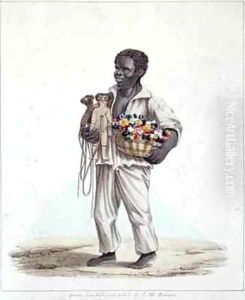J.M. Belisario Paintings
Isaac Mendes Belisario was a Jamaican artist of Jewish descent, known for his works depicting Jamaican life, culture, and ceremonies. Born in 1794 in Kingston, Jamaica, Belisario is recognized as one of the few artists from the Caribbean in the early 19th century whose works provide a valuable visual record of the period. His work is particularly significant given that it provides insights into the cultural practices of Jamaican society, including the lives of enslaved Africans and their descendants.
Despite being born into a prominent Jewish family in the colony, there is limited detailed information about his early life, education, and training as an artist. It is known that he traveled to London where he pursued his interest in art and developed his skills. During his time in England, he exhibited at the Royal Academy and the British Institution, which was a testament to his developing reputation as an artist.
Belisario's most famous works are a series of lithographs titled 'Sketches of Character,' which were published in the 1830s. These illustrations provide a colorful and vivid portrayal of the street life and the traditional folk characters of the Jonkonnu festival, a traditional Caribbean festival with African roots that was popular among the slave population. The series is considered an important historical record, as it captures aspects of the cultural heritage of Jamaica during a period when there were few visual documentations.
In addition to his lithographs, Belisario also painted portraits and landscapes that reflect his keen observation and attention to detail. His portraits often included members of the colonial elite, as well as individuals of diverse racial backgrounds, reflecting the complex social hierarchy of the time.
Belisario returned to Jamaica in the 1830s and continued to work and paint, contributing to the visual documentation of Jamaican society. He passed away in 1849, leaving behind a legacy that provides a unique visual window into the history and culture of Jamaica during the early to mid-19th century. His work continues to be studied and appreciated for its historical and artistic value, and original prints of his lithographs are sought after by collectors and institutions interested in Caribbean art and history.
